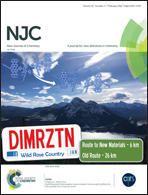Carbon dots prepared in different solvents with controllable structures: optical properties, cellular imaging and photocatalysis†
Abstract
The preparation of carbon dots (CDs) featuring almost the same structures in different solvents is beneficial for their direct applications in the desired media without additional treatment and for resource conservation. The structures of CDs, however, are vulnerable to the synthetic system, unfavorably forming “identical” CDs in different solvents. Herein, we developed a top-down method to explore the feasibility of preparing similar CDs from ZIF-8-derived solid porous carbons that comprising graphitic carbon embedded into the amorphous carbon domains in water, amide and alcohol. To attenuate the solvent effect, the porous carbon was oxidized by nitric acid prior to solvothermal/hydrothermal treatment. The use of oxidized porous carbon as precursors can result in the formation of CDs using a mild thermal treatment. Other than CDs prepared in amide (in DMF, CDs-d), the resulting CDs prepared in water (CDs-w) and in alcohol (in methanol, CDs-m) possess similar components and structures, as confirmed by XPS and DLS. Thus, both CDs-w and CDs-m aqueous suspensions exhibit excitation wavelength-dependent PL properties with the same emission maxima. CDs-w was directly applied in aqueous systems and gave slightly enhanced performance in cellular imaging and solar hydrogen evolution. Significantly, this research offers an available strategy to advance CD performance and reduce pollutant emission.



 Please wait while we load your content...
Please wait while we load your content...